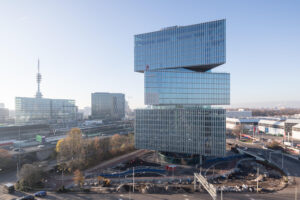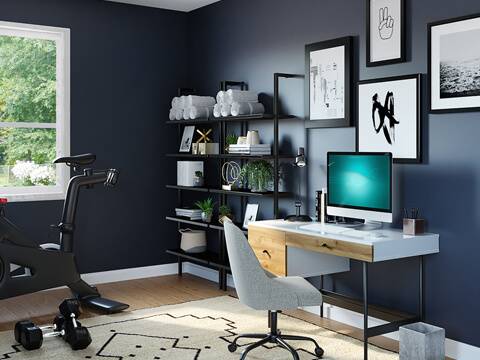Modular design is not a new concept, but it has gained renewed attention and investment in recent years, thanks to the advancement of digital tools, the changing consumer perceptions, and the need for more efficient and sustainable solutions in the construction sector.
How does modular design impact the design-build industry?
 This technique has the potential to transform the way we design and build structures, by shifting many aspects of building activity away from traditional construction sites and into factories with off-site, manufacturing-style production.
This technique has the potential to transform the way we design and build structures, by shifting many aspects of building activity away from traditional construction sites and into factories with off-site, manufacturing-style production.
This approach can offer several benefits for the design-build industry, such as:
– Faster project delivery: Modular design can reduce the project timeline by 20 to 50 percent, by allowing concurrent work on different phases of the project, such as design, fabrication, and site preparation. Modular design can also eliminate weather delays and improve quality control by using standardized processes and materials in a controlled environment.
– Lower costs: Modular design can reduce the project costs by 10 to 20 percent, by optimizing material use and minimizing waste, transportation, and labor costs. Modular design can also enable economies of scale and scope by producing multiple units with similar specifications and features.
– Higher quality: Modular design can enhance the quality and performance of the structures, by ensuring consistent standards and specifications across all modules. Modular design can also improve safety and durability by reducing the exposure of materials and components to environmental hazards and human errors.
– Greater flexibility: Modular design can increase the flexibility and adaptability of the structures, by allowing easy reconfiguration, expansion, relocation, or reuse of modules. Modular design can also enable customization and personalization by offering a variety of options and features for different modules.
What are the drawbacks of modular design?
Despite its advantages, modular design also faces some challenges and limitations, such as:
– Regulatory barriers: Modular design may encounter difficulties in complying with different codes and regulations across different jurisdictions, especially for cross-border projects. Modular design may also require special permits and inspections for transporting and installing modules on-site.
– Design constraints: Modular design may impose some restrictions on the architectural creativity and diversity of the structures, by limiting the size, shape, and weight of the modules. Modular design may also require more coordination and communication among different stakeholders involved in the project, such as designers, engineers, manufacturers, contractors, and owners.
– Market risks: Modular design may face uncertainties in the demand and supply of modules, especially for large-scale or complex projects. Modular design may also face competition from other construction methods or technologies that may offer lower costs or higher quality.
Modular Design vs Traditional Design-Build Construction
If you are planning to build a new home, office, or any other type of structure, you may be wondering whether to choose modular design or traditional design-build construction. Both methods have their advantages and disadvantages, and the best option for you may depend on your budget, timeline, design preferences, and sustainability goals. In this blog post, we will compare modular design and traditional design-build construction in terms of time, cost, quality, design, and sustainability.
Time
One of the main benefits of modular design is that it can save a lot of time in the construction process. Modular design involves building prefabricated modules or units in a factory setting, while the foundation and site work are done simultaneously. The modules are then transported and assembled on-site, reducing the need for multiple trades and inspections. According to JLL, a real estate services firm, modular design can reduce construction time on-site by 30% on average. This means that owners can occupy their buildings faster and start generating revenue sooner. For example, Triumph Modular, a modular construction company, claims that they can deliver a modular building in as little as 90 days.
Traditional design-build construction, on the other hand, is mostly linear and sequential. This means that each step of the construction process has to be completed before the next one can start, and there is less room for parallel activities. Traditional construction is also more vulnerable to delays caused by weather conditions, material shortages, change orders, or labor issues. These factors can increase the total construction time and affect the speed to occupancy.
Cost
Another important factor to consider when choosing between modular design and traditional design-build construction is cost. Modular design can offer some cost savings compared to traditional construction, but it is not necessarily cheaper in every case. Modular design can save costs by reducing labor hours, material waste, site disruption, and transportation costs. However, modular design also requires higher upfront costs for design, engineering, fabrication, and transportation. Additionally, modular design may have limited flexibility for customization or changes once the modules are built.
Traditional design-build construction can offer more cost predictability and control over the project budget. Traditional construction allows owners to start their design from the ground up and make adjustments as needed throughout the process. Traditional construction can also take advantage of local materials and labor markets, which may lower the overall costs. However, traditional construction can also incur higher costs due to longer construction time, material loss or damage, change orders, rework, or quality issues.
Quality
Quality is another aspect that can vary between modular design and traditional design-build construction. Modular design can offer higher quality standards than traditional construction because the modules are built in a controlled factory environment with strict quality control measures. Modular design can also ensure consistency and accuracy in the fabrication process by using advanced technologies such as computer-aided design (CAD) and computer-aided manufacturing (CAM). Modular design can also reduce the risk of defects or errors during transportation and installation by using specialized equipment and trained personnel.
Traditional design-build construction can also deliver high-quality results if done by experienced and skilled contractors. However, traditional construction is more prone to quality issues due to human error, weather conditions, material variability, or site conditions. Traditional construction may also require more inspections and testing to ensure compliance with building codes and regulations.
Design
Design is another factor that can influence the choice between modular design and traditional design-build construction. Modular design can offer some advantages in terms of design flexibility  and innovation compared to traditional construction. Modular design can allow for more customization and personalization of the modules by using different materials, finishes, colors, or layouts. Modular design can also enable more complex and creative designs by using modular components that can be stacked or arranged in various ways. Modular design can also adapt to different site conditions or constraints by using different sizes or shapes of modules.
and innovation compared to traditional construction. Modular design can allow for more customization and personalization of the modules by using different materials, finishes, colors, or layouts. Modular design can also enable more complex and creative designs by using modular components that can be stacked or arranged in various ways. Modular design can also adapt to different site conditions or constraints by using different sizes or shapes of modules.
Traditional design-build construction can also offer some benefits in terms of design freedom and creativity compared to modular design. Traditional construction can allow for more custom-designed structures that are tailored to the specific needs and preferences of the owners. Traditional construction can also accommodate more unusual materials or features that may not be available or feasible in modular design. Traditional construction can also create more unique and distinctive structures that reflect the local culture or context.
Sustainability
Sustainability is another aspect that can differentiate modular design from traditional design-build construction. Modular design can have a positive impact on the environment by reducing energy consumption, greenhouse gas emissions, material waste, and water usage during the construction process. Modular design can achieve these benefits by using prefabricated modules that require less energy and resources to produce than conventional materials. Modular design can also reduce the environmental impact of transportation by using fewer trucks or vehicles to transport the modules than traditional materials. Modular design can also improve the energy efficiency and performance of the buildings by using better insulation, ventilation, or lighting systems.
Traditional design-build construction can also have some environmental benefits compared to modular design, but they may not be as significant or consistent. Traditional construction can use more renewable or recycled materials than modular design, depending on the availability and cost of the materials. Traditional construction can also use more local or regional materials than modular design, which can reduce the transportation distance and emissions. Traditional construction can also incorporate more green features or technologies into the buildings, such as solar panels, rainwater harvesting, or green roofs.
Conclusion
Modular design is a promising construction technique that can offer significant benefits for the design-build industry, such as faster delivery, lower costs, higher quality, and greater flexibility. However, modular design also has some drawbacks that need to be addressed, such as regulatory barriers, design constraints, and market risks. Therefore, modular design requires careful planning and execution to ensure its success and sustainability.






